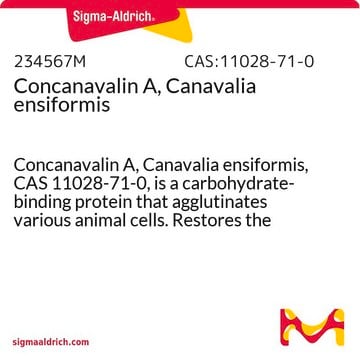C9705
Concanamycin A
≥70% (HPLC), crystals, vacuolar-type v-ATPase inhibitor
Synonym(s):
Folimycin
About This Item
Recommended Products
product name
Concanamycin A, ≥70% (HPLC)
Quality Level
Assay
≥70% (HPLC)
form
solid film
antibiotic activity spectrum
viruses
Mode of action
enzyme | inhibits
storage temp.
−20°C
SMILES string
CCC1C(O)C(C)C\C(C)=C\C=C\C(OC)C(OC(=O)\C(OC)=C\C(C)=C\C(C)C1O)C(C)C(O)C(C)[C@]2(O)C[C@@H](O[C@H]3C[C@@H](O)[C@H](OC(N)=O)[C@@H](C)O3)[C@H](C)C(O2)\C=C\C
InChI
1S/C46H75NO14/c1-13-16-34-28(7)37(58-38-22-33(48)43(31(10)57-38)60-45(47)53)23-46(54,61-34)30(9)41(51)29(8)42-35(55-11)18-15-17-24(3)19-26(5)39(49)32(14-2)40(50)27(6)20-25(4)21-36(56-12)44(52)59-42/h13,15-18,20-21,26-35,37-43,48-51,54H,14,19,22-23H2,1-12H3,(H2,47,53)/b16-13+,18-15+,24-17+,25-20+,36-21-/t26?,27?,28-,29?,30?,31-,32?,33-,34?,35?,37-,38+,39?,40?,41?,42?,43-,46+/m1/s1
InChI key
DJZCTUVALDDONK-LWLXYWDNSA-N
Looking for similar products? Visit Product Comparison Guide
General description
Application
- as a lysosomal inhibitor in young and old fibroblasts
- as a vacuolar-type H+-ATPase inhibitor in presynaptic vesicles
- as a lysosomal acidification blocker in HepG2 hepatocytes cells
Biochem/physiol Actions
Signal Word
Danger
Hazard Statements
Precautionary Statements
Hazard Classifications
Acute Tox. 1 Inhalation - Acute Tox. 2 Dermal - Acute Tox. 2 Oral - Eye Irrit. 2
Storage Class Code
6.1A - Combustible acute toxic Cat. 1 and 2 / very toxic hazardous materials
WGK
WGK 3
Flash Point(F)
Not applicable
Flash Point(C)
Not applicable
Personal Protective Equipment
Certificates of Analysis (COA)
Search for Certificates of Analysis (COA) by entering the products Lot/Batch Number. Lot and Batch Numbers can be found on a product’s label following the words ‘Lot’ or ‘Batch’.
Already Own This Product?
Find documentation for the products that you have recently purchased in the Document Library.
Customers Also Viewed
Our team of scientists has experience in all areas of research including Life Science, Material Science, Chemical Synthesis, Chromatography, Analytical and many others.
Contact Technical Service













